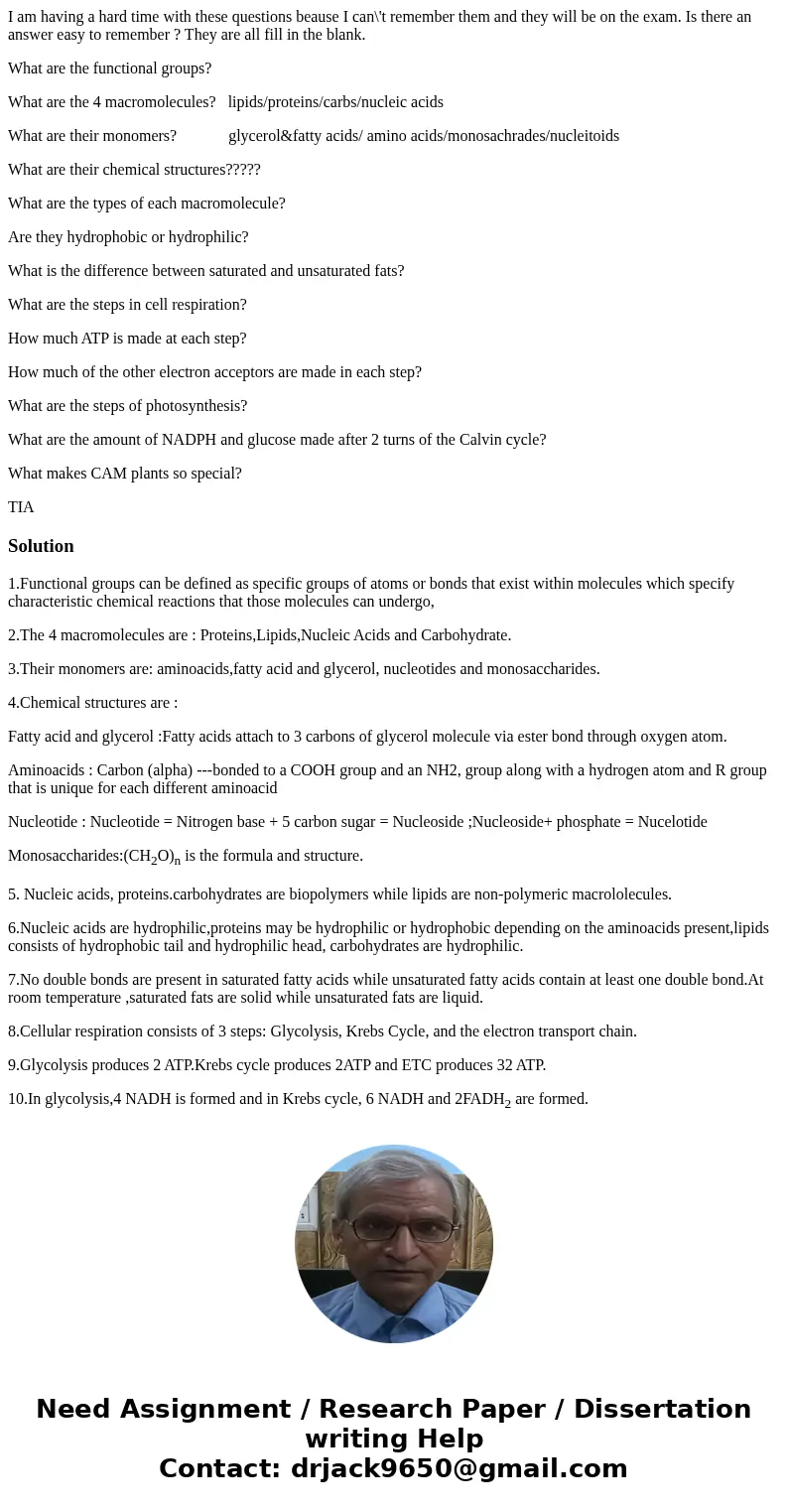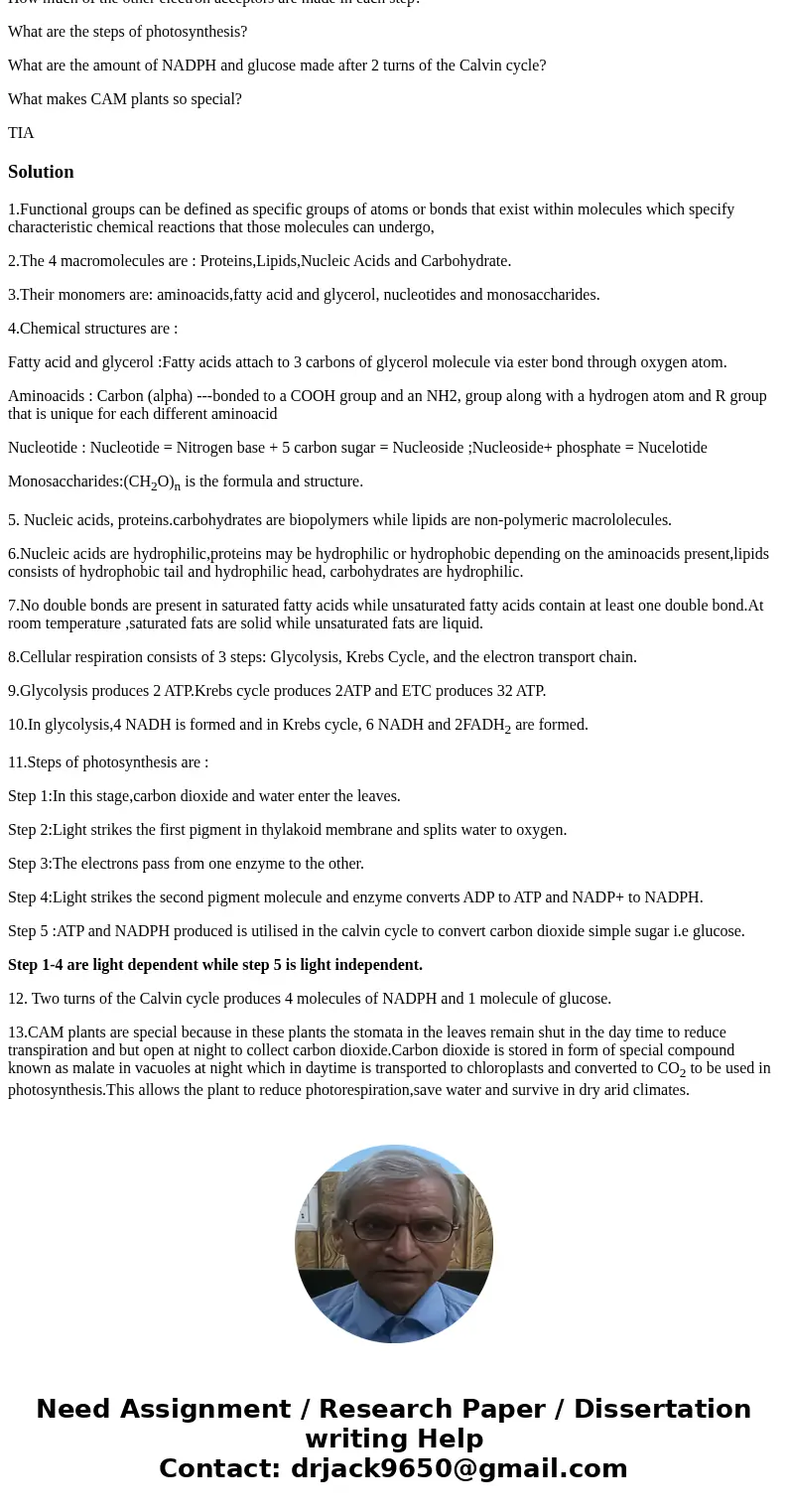I am having a hard time with these questions beause I cant r
I am having a hard time with these questions beause I can\'t remember them and they will be on the exam. Is there an answer easy to remember ? They are all fill in the blank.
What are the functional groups?
What are the 4 macromolecules? lipids/proteins/carbs/nucleic acids
What are their monomers? glycerol&fatty acids/ amino acids/monosachrades/nucleitoids
What are their chemical structures?????
What are the types of each macromolecule?
Are they hydrophobic or hydrophilic?
What is the difference between saturated and unsaturated fats?
What are the steps in cell respiration?
How much ATP is made at each step?
How much of the other electron acceptors are made in each step?
What are the steps of photosynthesis?
What are the amount of NADPH and glucose made after 2 turns of the Calvin cycle?
What makes CAM plants so special?
TIA
Solution
1.Functional groups can be defined as specific groups of atoms or bonds that exist within molecules which specify characteristic chemical reactions that those molecules can undergo,
2.The 4 macromolecules are : Proteins,Lipids,Nucleic Acids and Carbohydrate.
3.Their monomers are: aminoacids,fatty acid and glycerol, nucleotides and monosaccharides.
4.Chemical structures are :
Fatty acid and glycerol :Fatty acids attach to 3 carbons of glycerol molecule via ester bond through oxygen atom.
Aminoacids : Carbon (alpha) ---bonded to a COOH group and an NH2, group along with a hydrogen atom and R group that is unique for each different aminoacid
Nucleotide : Nucleotide = Nitrogen base + 5 carbon sugar = Nucleoside ;Nucleoside+ phosphate = Nucelotide
Monosaccharides:(CH2O)n is the formula and structure.
5. Nucleic acids, proteins.carbohydrates are biopolymers while lipids are non-polymeric macrololecules.
6.Nucleic acids are hydrophilic,proteins may be hydrophilic or hydrophobic depending on the aminoacids present,lipids consists of hydrophobic tail and hydrophilic head, carbohydrates are hydrophilic.
7.No double bonds are present in saturated fatty acids while unsaturated fatty acids contain at least one double bond.At room temperature ,saturated fats are solid while unsaturated fats are liquid.
8.Cellular respiration consists of 3 steps: Glycolysis, Krebs Cycle, and the electron transport chain.
9.Glycolysis produces 2 ATP.Krebs cycle produces 2ATP and ETC produces 32 ATP.
10.In glycolysis,4 NADH is formed and in Krebs cycle, 6 NADH and 2FADH2 are formed.
11.Steps of photosynthesis are :
Step 1:In this stage,carbon dioxide and water enter the leaves.
Step 2:Light strikes the first pigment in thylakoid membrane and splits water to oxygen.
Step 3:The electrons pass from one enzyme to the other.
Step 4:Light strikes the second pigment molecule and enzyme converts ADP to ATP and NADP+ to NADPH.
Step 5 :ATP and NADPH produced is utilised in the calvin cycle to convert carbon dioxide simple sugar i.e glucose.
Step 1-4 are light dependent while step 5 is light independent.
12. Two turns of the Calvin cycle produces 4 molecules of NADPH and 1 molecule of glucose.
13.CAM plants are special because in these plants the stomata in the leaves remain shut in the day time to reduce transpiration and but open at night to collect carbon dioxide.Carbon dioxide is stored in form of special compound known as malate in vacuoles at night which in daytime is transported to chloroplasts and converted to CO2 to be used in photosynthesis.This allows the plant to reduce photorespiration,save water and survive in dry arid climates.


 Homework Sourse
Homework Sourse